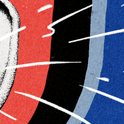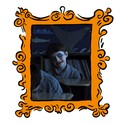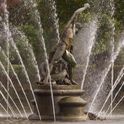Book: Rational Mysticism
Author: John Horgan
Price: (Houghton Mifflin, $25)
A British Zen Buddhist once observed that Robert Pirsig's 'Zen and the Art of Motorcycle Maintenance' cannot be about Zen, because "Zen isn't about anything." The Buddhist did have a point. If mystical experience is, by definition, ineffable, how much can you say about it?
The term "mysticism" has been applied to a broad family of both religious and secular oddities that are to be found in most known cultures-although at some times more than others. In the history of philosophy, the third to fifth centuries AD stand out as uncharacteristically dominated by occult attempts at spiritual transcendence. Closer to our own times, a small renaissance of mysticism took hold some 30 years ago. John Horgan, a distinguished American science journalist, who has now turned his attention to the topic, notes that in the 1970s "everybody I knew seemed to be reading 'Siddhartha', 'Be Here Now', 'The Doors of Perception', 'The Teachings of Don Juan', and other mystical texts. Everybody was pursuing mystical epiphanies-satori, kensho, nirvana, samadhi, the opening of the third eye-through transcendental meditation, kundalini yoga, LSD, or all of the above." High times for mysticism indeed-of which the new age movements of the 1990s may be seen as a faint but commercialised echo.
A good stab at defining the essence of mysticism, or what these diverse pursuits aim at, is to be found in the 1967 'Encyclopedia of Philosophy' "Mystical experience... is sensed as revealing something about the totality of things, something of immense human importance... upon which one's ultimate well-being or salvation wholly depends... It is often taken to be a confrontation... with the divine source of the world's being and man's salvation... There must be a unifying vision, a sense that somehow all things are one and share a holy, divine, and single life, or that one's individual being merges into a 'Universal Self'... A mystic may have no belief whatever in a divine being and still experience a sense of overwhelming beatitude, of salvation, or of lost or transcended individuality."
The main gap in this account is the dark side of mysticism, most familiar in the form of the "bad trips" that can be induced by mind-altering drugs. A few squares are inclined to rule any state produced by a drug as ipso facto not a genuine example of mysticism, or at least a very second-rate one. But, first, you don't need to ingest anything to have a bad trip, as Christian mystics such as St John of The Cross attested in his Dark 'Night of the Soul' (indeed, not ingesting anything at all may itself cause a trip-hence, according to some, the importance of fasting in some religious traditions). Secondly, the use of hallucinogens (or "entheogens," as the mystic crowd now calls them) is pretty widely accepted as a kosher route to transcendence, if anything is. Aldous Huxley's description of his experiments with mescalin 50 years ago, recounted in 'The Doors of Perception' and 'Heaven and Hell', did much to win this acceptance. And the role of drugs in the comfortably distant past of some religions is nowadays acknowledged by many scholars.
This has been taken to some amusing extremes, of course, perhaps most famously in the claims (again from the 1970s) that Christianity was originally a cult devoted to fly agaric, and that what we call Jesus was in fact a mushroom. More recently, the claim that Christ used cannabis to work his healing miracles has resurfaced: a recent issue of 'High Times', a pro-marijuana magazine, asks on its cover "Was Jesus a stoner?" Professors have duly been wheeled out in the press to attest that he was. Islam has largely escaped such pharmaceutical reinterpretation, although perhaps this is not surprising. Imagine the trouble Salman Rushdie would have faced if he had portrayed the Prophet as not merely immoral but a fungus.
Horgan's quest is to report from what he calls the border between science and spirituality. He talks to neurologists and other medics who try to map what goes on in the brain during mystical experiences, to scientists who aim to stimulate such experiences with electromagnetism and assorted paraphernalia, to drug researchers, religious scholars and even the odd guru. The book is firmly in the now-familiar tradition of the science travelogue. In this genre, laboratories, offices, restaurants and homes are toured, and scientists' appearances, mannerisms and even eating habits are dutifully transcribed. When a boffin's field is the human genome, or high-energy physics, these personal details can become wearyingly distracting. Do we still need reminding that chemists are people too? But it is entertainingly incongruous to read about middle-aged men, whose stock in trade is achieving a state of "absolute unitary being," sparring with obtuse waiters and carrying out their everyday chores.
In truth, not very much of the book is about science. Although plenty of the relevant empirical studies are discussed (often in footnotes), most of Horgan's interviewees are not scientists, and most of his commentary is more about the spiritual dim-ensions of life than about scientific attempts to quantify and analyse them. After all, there is little sound work to report. Yet his writing is still that of a good science journalist-he has a keen eye for gaps in the argument, a nose for unearthing conflicting evidence, and a sharp sense of what counts as a genuine explanation and what as waffle.
His first subject is Huston Smith, a veteran religious scholar and believer in the "perennial philosophy," the view that all mystical and spiritual traditions are revelations of the same underlying truth. Smith came to his convictions because of an experience in which he "glimpsed the pure light of the void," but Horgan finds him too quick to overlook the shortcomings and contradictions of various religions. Next up is Steven Katz, who teaches Jewish studies at Boston University and who derides the perennial philosophy on the grounds that spiritual experiences reflect personal and cultural circumstances, not an objective reality. He is dismissive of experiences triggered by drugs, as is Ken Wilber, a promoter of the perennial philosophy who has developed a classificatory hierarchy for mystical experiences. Wilber finds meditation the most reliable route to transcendence, although he is also keen on weightlifting.
At the opposite extreme in attitudes to drugs is the late Terence McKenna, sometimes called the Timothy Leary of the 1990s, who extols psychedelics as a path to enlightenment that is superior to any mainstream religion, and who believes that the visions produced by hallucinogenic plants and magic mushrooms are the roots of all human culture. He also thinks that DMT, a more potent hallucinogen than LSD, plunges us into a sort of hyperspace populated by aliens. Stanislav Grof, a Californian psychiatrist who believes that LSD is useful in treating alcoholism and depression, is similarly flaky, although he limits his flights of fancy to astral projection.
Compared with such exotica, one might have expected the work of Andrew Newberg, a radiologist at the University of Pennsylvania Medical Centre, and his late colleague, Eugene d'Aquili, a psychiatrist, to be a breath of rationalist fresh air. Newberg uses a variant of Positron Emission Tomography (PET) to monitor the metabolic activity in regions of the brains of meditating Tibetan monks and Franciscan nuns. But although they employ the most advanced apparatus of empirical science, Newberg and his ilk may be the most confused investigators in the field. In their book, 'Why God Won't Go Away: Brain Science and the Biology of Belief' (2001), Newberg and d'Aquili claim to trace feelings of mystical unity to depressed activity in the posterior superior parietal lobe, and say that their scans lend credence to mystical ideas. Horgan points out that their experimental results are contradicted by those of other researchers (indeed Horgan finds no well-corroborated results in the field), but a deeper problem is the authors' conceptual muddle. If physiologists could find out what was going on in Macbeth's head when he thought he saw a dagger, would that show that it was a real dagger that he saw? Of course not. The fact that scientists can in some cases explain what is going on in our brains when we experience an optical illusion does not imply that such experiences aren't illusions.
Newberg thinks that his brain scans prove the accounts of mystics to be based "not on delusional ideas, but on experiences that are neurologically real." But the possibility that all mystical experiences are merely delusional should not be discounted. Can countless thousands of the intoxicated, the starving, the sleep-deprived, the drugged, the poisoned, the exhausted, the suffering, the solitary, the unstable and the pathologically religious possibly be wrong? Well, yes; they very well might be.
There is a further problem with regarding any mystical experience as informing us of the underlying nature of reality, irrespective of what any neurophysiologist might find. It is that we do not have a clue what it would mean for any mystical claim to be true. Imagine a world in which, as the mystics say, "all is one," and another in which it isn't. What in concrete terms is the difference between them? If the mystic cannot say-and, by definition, he cannot-then what are we talking about? Horgan does not engage directly with this conundrum, but his conclusions show that he fully appreciates it. He quotes approvingly a remark heard at a conference, "What you can't say, you can't say, and you can't whistle it either" (this dictum is in fact lifted from the late Cambridge philosopher, Frank Ramsey, brother of the late Archbishop Ramsey).
Horgan ends up deciding that the value of mysticism-or indeed spirituality, since for him the two seem to come to much the same thing-lies not in its claim to describe any truth about the world, but in the attitudes of reverence and wonder that it can engender, of "seeing life against the background of infinity." Science, he assures us, can never answer the mystery of why there is something rather than nothing.
Mysticism, he finds, reminds us how much we don't know, and in this he spies the grounds of a reconciliation with science. This was exactly the conclusion drawn by Bertrand Russell in 1914, when he wrote that "the cautious and patient investigation of truth by science, which seems the very antithesis of the mystic's swift certainty, may be fostered and nourished by that very spirit of reverence in which mysticism lives and moves." The swift certainties that marked the classical mystics discussed by Russell are notably absent from the mystical enthusiasts interviewed by Horgan, who tend to be more circumspect-so maybe some progress towards enlightenment is being made after all.











